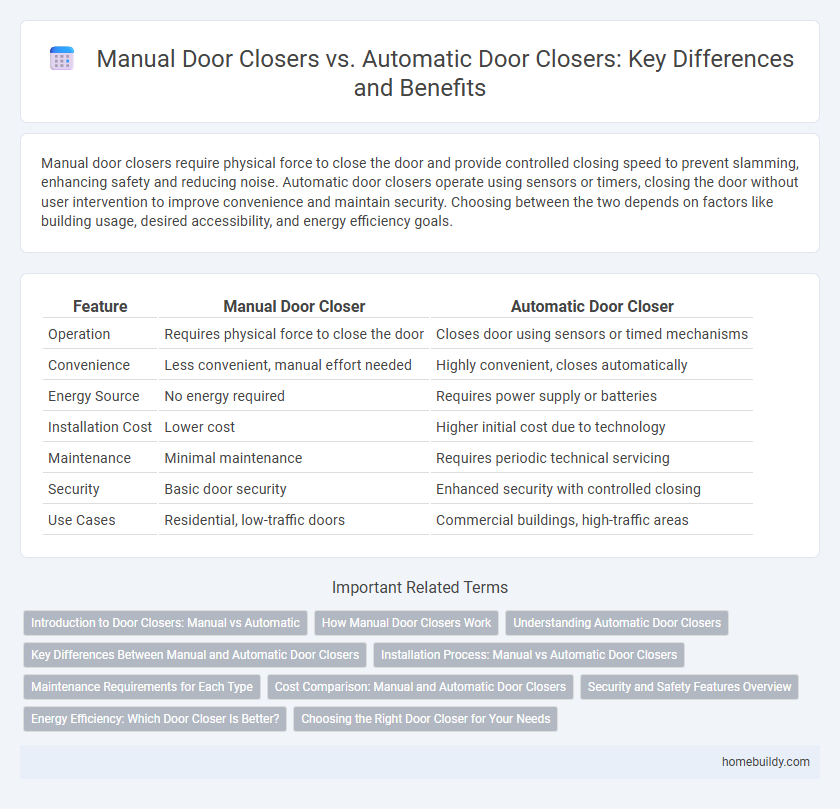Manual door closers require physical force to close the door and provide controlled closing speed to prevent slamming, enhancing safety and reducing noise. Automatic door closers operate using sensors or timers, closing the door without user intervention to improve convenience and maintain security. Choosing between the two depends on factors like building usage, desired accessibility, and energy efficiency goals.
Table of Comparison
| Feature | Manual Door Closer | Automatic Door Closer |
|---|---|---|
| Operation | Requires physical force to close the door | Closes door using sensors or timed mechanisms |
| Convenience | Less convenient, manual effort needed | Highly convenient, closes automatically |
| Energy Source | No energy required | Requires power supply or batteries |
| Installation Cost | Lower cost | Higher initial cost due to technology |
| Maintenance | Minimal maintenance | Requires periodic technical servicing |
| Security | Basic door security | Enhanced security with controlled closing |
| Use Cases | Residential, low-traffic doors | Commercial buildings, high-traffic areas |
Introduction to Door Closers: Manual vs Automatic
Manual door closers rely on physical effort to close doors, often featuring adjustable tension mechanisms for controlled closing speed and force. Automatic door closers use sensors or electric motors to close doors without user intervention, enhancing convenience and accessibility in high-traffic areas. Both types improve security and energy efficiency by ensuring doors close reliably after opening.
How Manual Door Closers Work
Manual door closers operate through mechanical components such as springs and hinges that control the door's closing speed and force without electrical power. When a door is opened, the spring inside the closer compresses and then gradually releases, ensuring the door closes smoothly and securely. These devices allow precise adjustment of the closing tension and speed to prevent slamming and ensure safety in high-traffic areas.
Understanding Automatic Door Closers
Automatic door closers use sensors or electric mechanisms to ensure doors close securely after opening, enhancing convenience and safety in high-traffic areas. Unlike manual door closers that rely on physical force to close, automatic models provide consistent operation without user intervention, reducing wear and improving accessibility. These devices optimize energy efficiency by maintaining controlled door movement, preventing drafts and temperature loss.
Key Differences Between Manual and Automatic Door Closers
Manual door closers require physical effort to operate, relying on user force to open and close doors, making them suitable for low-traffic areas or budget-conscious installations. Automatic door closers use sensors or electric mechanisms to control door movement, enhancing accessibility, security, and energy efficiency in commercial and high-traffic environments. Key differences include operation method, installation complexity, maintenance needs, and cost, with automatic closers offering convenience and compliance with accessibility standards.
Installation Process: Manual vs Automatic Door Closers
Manual door closers typically offer a straightforward installation process, requiring basic tools and minimal adjustments to fit various door sizes and weights. Automatic door closers involve a more complex setup, often necessitating electrical connections, calibration of sensors, and integration with access control systems. Understanding the installation requirements helps optimize performance and ensure compliance with building codes.
Maintenance Requirements for Each Type
Manual door closers require regular inspection of mechanical parts such as springs, hinges, and adjustment screws to ensure smooth operation and prevent wear. Automatic door closers, equipped with electronic sensors and motors, demand more specialized maintenance including software updates, sensor calibration, and electrical component checks to maintain optimal functionality. Proper upkeep of both types extends device lifespan and ensures reliable door closing performance in various environments.
Cost Comparison: Manual and Automatic Door Closers
Manual door closers generally have a lower upfront cost compared to automatic door closers, making them an economical choice for budget-conscious projects. Automatic door closers involve higher initial expenses due to advanced sensors and motorized components but offer energy savings and enhanced accessibility that can reduce long-term operational costs. Maintenance costs for manual door closers tend to be minimal, while automatic models may require more frequent servicing and repairs, potentially impacting overall cost efficiency.
Security and Safety Features Overview
Manual door closers provide consistent control over door closure speed and strength, reducing the risk of door slamming and enhancing safety. Automatic door closers integrate advanced security features such as electronic locking, fire-resistance controls, and sensor-triggered closing mechanisms that ensure doors close securely without user intervention. Combining both technologies can optimize security by ensuring doors remain closed during emergencies while preventing unauthorized entry.
Energy Efficiency: Which Door Closer Is Better?
Manual door closers rely on user intervention, often leaving doors partially open and leading to energy loss through air leakage, whereas automatic door closers use sensors and timing mechanisms to ensure doors close completely, significantly improving energy efficiency. By maintaining consistent closure, automatic door closers reduce heating and cooling costs by minimizing drafts and heat transfer. The integration of smart technology in automatic door closers further optimizes energy savings in commercial and residential buildings.
Choosing the Right Door Closer for Your Needs
Manual door closers provide precise control and are ideal for low-traffic areas where user operation is preferred, while automatic door closers offer hands-free convenience and enhanced accessibility suitable for high-traffic or commercial environments. Selecting the right door closer depends on factors such as door weight, frequency of use, security requirements, and compliance with accessibility standards like ADA. Evaluating these criteria ensures optimal functionality, user safety, and energy efficiency in both residential and commercial applications.
manual door closer vs automatic door closer Infographic

 homebuildy.com
homebuildy.com